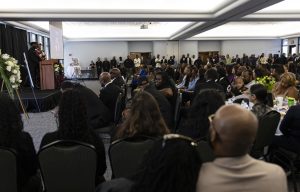‘They’re going through higher education by themselves’ : The foster student experience
Only 3-5% of foster students are estimated to complete undergraduate studies

Sac State alumna Emmerald Evans was one of several students who went through the foster system. She said her ultimate goal was to become an attorney for foster youth, inspired by her own experience. (Profile photo: courtesy of Emmerald Evans. Background photo: Jacob Peterson. Graphic made in Canva by Kamelia Varasteh)
December 3, 2022
Sacramento State prides itself on meeting the needs of communities on campus and on those communities being the most diverse in the CSU system.
One group of students tend to be forgotten about: students from a foster youth background, Sac State Alumna Emmerald Evans said.
Often, these students face as many issues as their non-foster peers, but without the same kind of support system backing them up, Evans said.
According to a 2016 study for the Children & Youth Services Review journal, only 3-5% of college students who came from a foster background are estimated to complete undergraduate studies, compared to 28.8% for non-foster students.
The story continues below the video.
As someone who went through foster youth college experience herself, Evans graduated in May with a degree in criminal justice.
Evans said her ultimate goal was to become an attorney for foster youth based on her own background.
She has been involved with advocacy for foster students through Seneca Family of Agencies and the John Burtons Advocates for Youth advocacy groups, she said.
“I was benefited to have a great support system who encouraged me,” Evans said. “But even with that, you’re still dealing with — when you’re thinking of someone who went through care — trauma, right? You’re dealing with PTSD… you’re dealing with all these other things that impact your day-to-day life to be able to show up as a college student 100% every time.”
Evans said she made use of resources like Assembly Bill 12, which allows qualified students to stay in foster care until the age of 21, and The Guardian Scholars Program. In place at Sac State since 2006, the program’s office is currently located inside Lassen Hall.”
“I was connected to Guardian Scholars, which is a on-campus support service specifically directed for foster youth,” Evans said. “They were pretty helpful with getting my priority registration and some of the events they have that helped supported [students].”
Senior Program Coordinator Susan Kischmischian joined the program in 2016 and said one of the main differences in the needs of foster students compared to the non-foster students was support.
“They’re going through higher education by themselves, typically,” Kischmischian said. “We kind of serve as — I call it bumper guards. We’re here to help support them with anything they need support in, It’s just a matter of getting those students in to ask for help.”
The story continues below the image.

Kischmischian said that, as a result of having to face a more challenging time in their youth, many of these students do not like asking for help.
She said the Guardian Scholars Program worked with other departments, such as the Financial Aid Office and the Crisis Assistance & Resource Educations Support to help support the students.
“We try to do a soft, warm hand-off to those offices,” Kischmischian said. “We work for an amazing campus to where we’re not siloed. We want to help each other.”
The Guardian Scholars Program’s co-coordinator and case manager, Angelica Perez, joined the program in 2019. Perez said she comes from a foster background herself.
“I was in foster care when I was really young,” Perez said. “My sister took me and six of my siblings in. She was 20 at the time, so she was very, very, very young.”
The story continues below the image.

Perez said many of the foster students coming to Sac State were first generation college students and didn’t have guidance from a family member who went to a CSU.
She said this group of students had a greater need for certain resources, but housing and financial resources were two of the most pressing.
“A lot of our students don’t have a home to go to, so when they move to Sacramento, this is their new home,” Perez said. “We need to help them find affordable housing – which is very difficult right now – especially with the increase in cost of living. So many of our students are relying heavily on their financial aid, or if they have a job, that income.”
Perez said the program has seen an increase in graduation rates for the students who were a part of it.
Twenty-four foster students received their degrees last year, both graduate and undergraduate. The program was seeing a consistent flow of students entering the program and graduating, with a retention rate of currently being 87%, Perez said.
“I’m really proud of last year’s graduation class, because they went through that transition of COVID,” Perez said. “All of those students sticked it out, and kept their graduation semester, and that’s huge.”
Evans said the CSU system received $12 million to expand foster youth programs as part of the state budget, adding that she wanted foster youth to be assured that work was being done to provide support to them.
“This is a population we don’t recognize or highlight enough,” Evans said. “That they’re here and what they’re doing and how much it takes to show up.”

































































































































